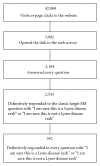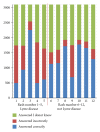Bull's-Eye and Nontarget Skin Lesions of Lyme Disease: An Internet Survey of Identification of Erythema Migrans
- PMID: 23133445
- PMCID: PMC3485866
- DOI: 10.1155/2012/451727
Bull's-Eye and Nontarget Skin Lesions of Lyme Disease: An Internet Survey of Identification of Erythema Migrans
Abstract
Introduction. Lyme disease is an emerging worldwide infectious disease with major foci of endemicity in North America and regions of temperate Eurasia. The erythema migrans rash associated with early infection is found in approximately 80% of patients and can have a range of appearances including the classic target bull's-eye lesion and nontarget appearing lesions. Methods. A survey was designed to assess the ability of the general public to distinguish various appearances of erythema migrans from non-Lyme rashes. Participants were solicited from individuals who visited an educational website about Lyme disease. Results. Of 3,104 people who accessed a rash identification survey, 72.7% of participants correctly identified the classic target erythema migrans commonly associated with Lyme disease. A mean of 20.5% of participants was able to correctly identify the four nonclassic erythema migrans. 24.2% of participants incorrectly identified a tick bite reaction in the skin as erythema migrans. Conclusions. Participants were most familiar with the classic target erythema migrans of Lyme disease but were unlikely to correctly identify the nonclassic erythema migrans. These results identify an opportunity for educational intervention to improve early recognition of Lyme disease and to increase the patient's appropriate use of medical services for early Lyme disease diagnosis.
Figures
Similar articles
-
The Spectrum of Erythema Migrans in Early Lyme Disease: Can We Improve Its Recognition?Cureus. 2022 Oct 25;14(10):e30673. doi: 10.7759/cureus.30673. eCollection 2022 Oct. Cureus. 2022. PMID: 36439577 Free PMC article.
-
Not All Erythema Migrans Lesions Are Lyme Disease.Am J Med. 2017 Feb;130(2):231-233. doi: 10.1016/j.amjmed.2016.08.020. Epub 2016 Sep 6. Am J Med. 2017. PMID: 27612442
-
Physician-diagnosed erythema migrans and erythema migrans-like rashes following Lone Star tick bites.Arch Dermatol. 1998 Aug;134(8):955-60. doi: 10.1001/archderm.134.8.955. Arch Dermatol. 1998. PMID: 9722725
-
Erythema migrans.Med Clin North Am. 2002 Mar;86(2):239-60. doi: 10.1016/s0025-7125(03)00085-3. Med Clin North Am. 2002. PMID: 11982300 Review.
-
Skin manifestations of lyme borreliosis: diagnosis and management.Am J Clin Dermatol. 2008;9(6):355-68. doi: 10.2165/0128071-200809060-00002. Am J Clin Dermatol. 2008. PMID: 18973402 Review.
Cited by
-
Atypical Lyme Disease Rash: A Case Report.Cureus. 2024 Feb 23;16(2):e54779. doi: 10.7759/cureus.54779. eCollection 2024 Feb. Cureus. 2024. PMID: 38529463 Free PMC article.
-
Neuropsychiatric Symptoms and Tick-Borne Diseases.Curr Top Behav Neurosci. 2023;61:279-302. doi: 10.1007/7854_2022_406. Curr Top Behav Neurosci. 2023. PMID: 36512289
-
Post-treatment Lyme Disease as a Model for Persistent Symptoms in Lyme Disease.Front Med (Lausanne). 2020 Feb 25;7:57. doi: 10.3389/fmed.2020.00057. eCollection 2020. Front Med (Lausanne). 2020. PMID: 32161761 Free PMC article. Review.
-
Erythema from the Woods.Indian Dermatol Online J. 2025 Jan 20;16(3):496-498. doi: 10.4103/idoj.idoj_705_23. eCollection 2025 May-Jun. Indian Dermatol Online J. 2025. PMID: 40395602 Free PMC article. No abstract available.
-
The Spectrum of Erythema Migrans in Early Lyme Disease: Can We Improve Its Recognition?Cureus. 2022 Oct 25;14(10):e30673. doi: 10.7759/cureus.30673. eCollection 2022 Oct. Cureus. 2022. PMID: 36439577 Free PMC article.
References
-
- Seidel MF, Domene AB, Vetter H. Differential diagnoses of suspected Lyme borreliosis or post-Lyme-disease syndrome. European Journal of Clinical Microbiology and Infectious Diseases. 2007;26(9):611–617. - PubMed
-
- Djukic M, Schmidt-Samoa C, Nau R, von Steinbüchel N, Eiffert H, Schmidt H. The diagnostic spectrum in patients with suspected chronic Lyme neuroborreliosis—the experience from one year of a university hospital’s Lyme neuroborreliosis outpatients clinic. European Journal of Neurology. 2011;18(4):547–555. - PubMed
-
- Ljøstad U, Skogvoll E, Eikeland R, et al. Oral doxycycline versus intravenous ceftriaxone for European Lyme neuroborreliosis: a multicentre, non-inferiority, double-blind, randomised trial. The Lancet Neurology. 2008;7(8):690–695. - PubMed
-
- Oksi J, Nikoskelainen J, Hiekkanen H, et al. Duration of antibiotic treatment in disseminated Lyme borreliosis: a double-blind, randomized, placebo-controlled, multicenter clinical study. European Journal of Clinical Microbiology and Infectious Diseases. 2007;26(8):571–581. - PubMed
-
- Cottle LE, Mekonnen E, Beadsworth MBJ, Miller ARO, Beeching NJ. Lyme disease in a British referral clinic. Quarterly Journal of Medicine. 2012;105(6):537–543. - PubMed
LinkOut - more resources
Full Text Sources
Other Literature Sources




